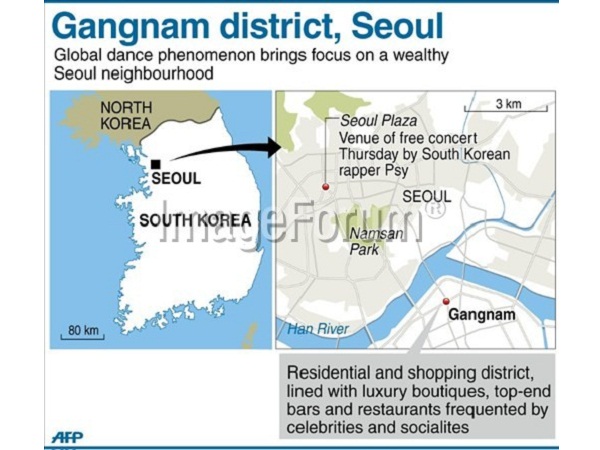
SEOUL—Hundreds of millions have watched the dance and listened to the song— most without understanding a word—but very few have any idea what “Gangnam” is and what, if any, particular “style” it might have.
The Gangnam in the title of the global hit by South Korean rapper Psy is Seoul’s wealthiest residential and shopping district, lined with luxury boutiques, top-end bars, night clubs and restaurants frequented by celebrities.
But even among those Koreans who live or party regularly in Gangnam, which literally and unglamorously translates as “south of the river”, there is little consensus on what constitutes the district’s signature style.
Translating the song’s lyrics, which some see as satirizing the district’s self-importance and ostentatious wealth, offers little in the way of concrete insights.
Psy sings about being the “guy who downs boiling coffee in one shot” and who “goes completely crazy when the right time comes.”
Kwon Yu-Bi, a 23-year-old student and Gangnam night-life regular, said the song was less about any particular place and more about a new-found hedonism in Asia’s fourth largest economy.
“Gangnam is just a symbolic place and I think the song really reflects Korea, where young people, including myself, enjoy a hectic and crazy night out,” Kwon told AFP.
A Gangnam residential address doesn’t come cheap, with the average apartment price —even with Seoul going through an extended real estate slump—set at around $720,000.
One particular street, lined on both sides with outlets of global luxury brands such as Louis Vuitton, Gucci, Cartier and Prada has been compared to Rodeo Drive of Beverly Hills in California.
For Kim Hoo-Yeon, 23, the real Gangnam style equates to nothing more than an obsession with conspicuous consumption.
“Every time I go to Gangnam, I feel people come to show off how much money they have,” she said.
“I don’t even feel it’s worthwhile labelling it ‘Gangnam style’,” agreed 29-year-old Park Seong-Jun, who said the place was simply a magnet for anyone who could afford to go on a “crazy money-spending spree”.
The video that launched Psy and “Gangnam Style” to global fame and has notched up nearly 500 million views on YouTube certainly appears to poke fun at the district’s image of idle affluence.
It features the rapper breezing through a world of speed boats, yoga classes and exclusive clubs—all the while performing an eccentric horse-riding dance accompanied by beautiful models.
The implied emphasis on superficiality over substance is reinforced by the fact that the real Gangnam is well-known for celebrity-frequented plastic surgery clinics.
But Kim Soo-Mi, 49, who works as a pharmacist and has lived in Gangnam for 15 years, believes the image is a false one.
“It’s a pity that only the negative sides of Gangnam have been known through the song, since there’s so much more to the area than that,” said Kim, who sees her neighbourhood as sophisticated rather than glamorous.
“When I visit other areas, that’s when I really feel Gangnam is a trendsetter—not just for fashion but for lifestyle in general,” she said.
And J.H. Lim, the owner of a high-end restaurant in the area, said Gangnam’s style was one of refined taste that appealed to a mature clientele.
“If someone’s looking for fast-paced fun and energy, there are other places in Seoul for that. Gangnam is more for high-profile adults, who want to enjoy the luxury and exclusivity”, the 55-year-old entrepreneur said.